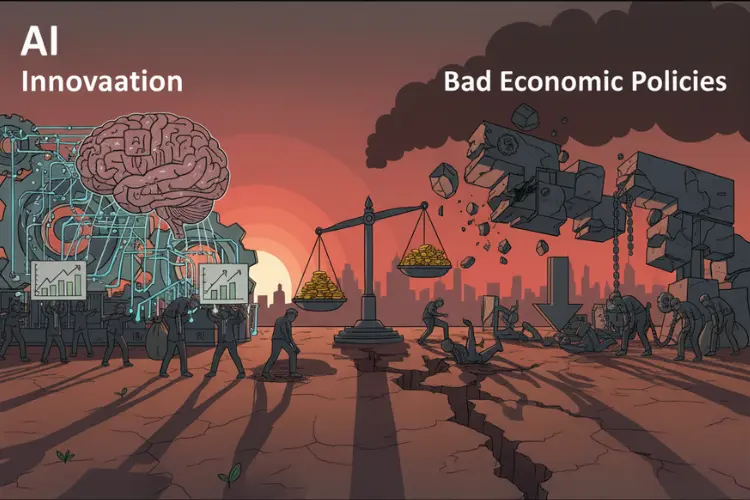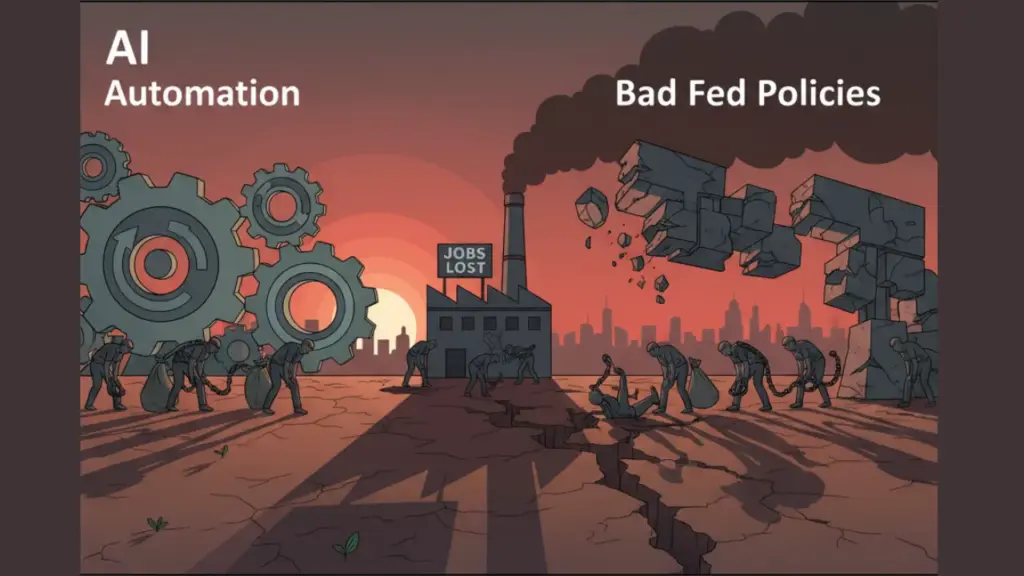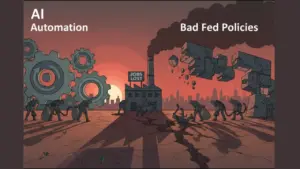Introduction
The media loves blaming artificial intelligence for job losses. Headlines scream about robots replacing humans and AI taking over industries. But this narrative is misleading. The truth is far more complex. It’s not AI that’s killing jobs—it’s artificially high interest rates and poor Federal Reserve management.
Every business owner should understand the real cause of layoffs. Misinterpreting AI as the enemy can lead to wrong business strategies. In reality, companies are investing in AI not to eliminate jobs, but to survive financially challenging times.
This blog breaks down the economics behind the AI jobs myth. It explains why bad monetary policy, not automation, is the real threat to employment.
Jerome Powell’s Narrative on AI and Job Losses
Jerome Powell, the Federal Reserve Chair, recently blamed AI for rising unemployment. According to him, automation is replacing human labor, and AI advancements are forcing companies to cut staff.
But this narrative is misleading. Powell oversimplifies the problem. AI adoption has grown steadily for years, yet job losses correlate more closely with economic policies than with technology.
By pointing to AI, Powell shifts attention away from the Federal Reserve’s decisions. High interest rates and mismanaged monetary policies are often the hidden forces behind layoffs.
The Reality: Artificially High Interest Rates
High interest rates are meant to curb inflation. But when rates rise too fast or too high, they create a financial chokehold on businesses.
Companies borrow money to invest in growth, pay salaries, and fund operations. When borrowing becomes expensive, businesses face tough choices. Cutting costs—often through layoffs—becomes necessary.
High rates slow down hiring and expansion. They also make startups hesitant to invest in new projects. Even profitable companies may reduce staff simply to survive.
For example, tech companies have cut thousands of jobs over the past year. Many of these layoffs aren’t due to AI adoption. Instead, they stem from the cost of borrowing and the pressure to maintain profitability in a high-interest environment.
Fed Mismanagement and Its Impact on Jobs
The Federal Reserve’s role is crucial. Missteps can ripple through the economy. Poorly timed rate hikes or inconsistent policies create uncertainty for businesses.
Uncertainty leads to delays in hiring, investment, and expansion. Companies can’t plan effectively, and many adopt a defensive stance. Cutting jobs becomes a reactive measure.
It’s a cycle. Mismanaged monetary policy increases financial strain, businesses cut costs, and media narratives blame AI. Meanwhile, the real cause—policy-induced financial pressure—remains hidden.
Why Companies Are Investing in AI
AI is not the villain. Companies adopt AI to survive, not to destroy jobs. Automation helps reduce operational costs and improve efficiency.
For example, a company facing high interest payments may use AI for customer service or analytics. This allows them to stay competitive without compromising quality. In many cases, AI supplements human work rather than replaces it.
Fractional CTOs often guide startups in adopting AI strategically. They ensure technology investments solve real business problems rather than just chasing hype. This approach helps companies survive financial strain while creating long-term value.
The Economics Behind the AI Jobs Myth
The AI jobs myth thrives on misunderstanding economic dynamics. Media narratives often connect AI deployment with layoffs without examining underlying causes.
Economic data tells a different story. In sectors where AI adoption is high, overall productivity often increases, leading to new opportunities and roles. Job losses usually occur in industries most affected by financial stress, not automation.
Artificially high interest rates create an environment where businesses cannot take risks. Investment slows, hiring freezes appear, and layoffs happen. Blaming AI masks the true economic cause: poor monetary policy.
Startups and established companies alike must look at financial fundamentals. High interest costs and liquidity issues drive layoffs more than any machine learning model ever could.

Implications for Business Owners
Understanding the real threat is essential for business owners. Misattributing layoffs to AI can lead to misguided strategies, such as avoiding technological adoption altogether.
Instead, business owners should focus on:
- Financial Health: Monitor interest exposure and cash flow.
- Strategic AI Adoption: Invest in AI to enhance operations, guided by experts or fractional CTOs.
- Flexible Workforce Planning: Prepare for economic fluctuations without panicking.
- Policy Awareness: Understand how Fed decisions affect borrowing, growth, and employment.
AI can be an ally if used strategically. Fractional CTOs and advisors play a key role in balancing technological adoption with financial prudence.
Conclusion
The narrative that AI is killing jobs is a myth. High interest rates and mismanaged monetary policy are the real culprits. Businesses that understand this can make smarter decisions, protect employees, and invest in technology wisely.
AI adoption is not a threat—it’s a survival tool. Fractional CTOs and strategic advisors help companies navigate these challenges effectively. By separating myth from reality, business owners can focus on growth, resilience, and innovation.
For readers curious about more insights on navigating technology, finance, and business strategy, visit StartupHakk. It’s a hub for understanding modern business challenges beyond misleading narratives.




